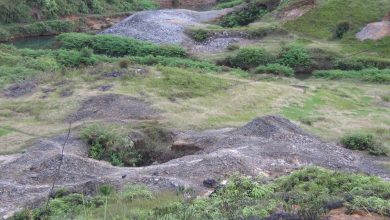A botched operation, says commission on death of Cherish

Shillong, Sept 9: The report of the justice T Vaiphei inquiry commission pointed out that the operation to capture former HNLC leader Cherishtarfield Thangkhiew was botched.
“In my considered view, the operation was a well-laid plan, but executed poorly, recklessly, hastily and without proper application of mind. In order words, it was a botched-up operation and failing in its objective of apprehending the deceased alive, who would have given valuable information to the police about the subversive activities of the proscribed HNLC outfit” the report said.
The report said the operation carried out at the residence of Thangkhiew to arrest him on August 13, last year was done in a reckless manner and was a ‘culpable, thoughtless and excessive use of force’, which resulted in his death.
“Therefore, my finding is that the Tactical Team-I in carrying out the operation to arrest the deceased at his residence on August 13, 2021 at about 3 AM was culpable of thoughtless and excessive use of force, which resulted in the death of the deceased, late Cheristerfield Thangkhiew, which turned out to be avoidable”, the report said.
“In my considered view, the post facto excuse that none but the deceased was hurt cannot be a valid justification for carrying out the operation hastily and in a reckless manner by the Tactical Team-I,” the commission said.
According to the report, the common thread of evidence running through the statements of the state witnesses is that the objective of operation was professed to be simply to capture the deceased alive and not to shoot at him. This was also the decision taken in the tactical meeting held prior to the operation.
He said the fact that by undertaking such reckless operation, the team completely lost sight of the possibility of harming the family members of the deceased, who were never accused of having anything to do with the nefarious activities of the deceased he was charged of.
“If the primary objective of carrying out the operation was to capture the deceased alive, the manner in which the raid was conducted unnecessarly gives rise to the impression that that was not so. This is most unfortunate,” the report said.
“Coming now to the killing of the deceased, the evidence of the state witness no 4 is that in that meeting (the tactical meeting held prior to the operation), there was no talks regarding intelligence information as to who were present with the deceased at his house on that night”.
When they reached the gate of the residence of the deceased, they called out to him (Cherishtarfield) 2-3 times to make their presence felt, but there was no response from the deceased or his family members.
It was drizzling at the time of the operation, but it was not a heavy shower. On reaching the main door of the first floor, they knocked at the door three times, but there was no response and forcibly opened the door.
The state witness No 4 said they were instructed during their training that having a torch in the corridor of a dwelling house in the course of operation against militant outifts would not have helped as that would have only helped them to target them and also that a torch was not necessary in an in house arrest.
He also said after their team forcibly opened the door outward, he was the first to enter the narrow corridor which is approximately 3 feet wide.
The corridor was completely dark. He had proceeded further into the corridor and had almost reached the end of the corridor when, suddenly, in the cover of darkness, one person came charging towards him aggressively by making a loud noise.
It had appeared to him in the darkness that he was raising his hand and was about to atack him whereupon he shouted “Sangeh Sangeh!” (Stop, stop!).
“When the aggressor did not stop and continued to charge aggressively (at that time, the distance between him the aggressor was barely 2-3 feet), he, fearing imminent attack by the aggressor, was left with no option but, in a split second decision, fired only one round from his service weapon at the lower portion of the aggressor. That person sustained a bullet injury and collapsed. The other members of the tactical team were behind him”.
Thereafter, followed by other senior officers entered the room where the deceased was shot at.
When the light was turned on, the injured was seen lying on the floor and was identified as the deceased, late Cherishtarfield Thangkhiew. A knife was also found. In his examination by counsel for the commission, the witness denied that he had used excessive force by firing at the deceased.
The commission said in his opinion, having entered what could potentially be a lion’s den in darkness without proper planning and without taking adequate precaution, state witness no 4 had taken purely avoidable and unnecessary risk endangering his own life and that of deceased whom the team professed to have not intended to kill him in the first place.
“In my opinion, the forced entry into the house of the deceased in darkness and the subsequent killing of the deceased was a reckless exercise and tantamount to disproportionate use of force, which resulted in the death of the deceased,” he said and added that this apparently defeated the very purpose of launching the operation, which is to capture him alive.
As the deceased was never apprehended alive; it was thus a futile exercise, the report said.
“Had they waited for about 2 hours or so to let the daylight to emerge, cordoned off the house of the deceased (as they actually did it here) in the meantime and lobbed teargas grenade into the rooms occupied by the deceased and his family, they could have been forced to come out of the house; the deceased could have been easily apprehended by this means. In this way, the safety of the other innocent members of the family of the deceased could also be ensured”, the commission said.
According to the report, there is another aspect of the matter, which cannot be lost sight of. It is an admitted position of the state witnesses that the deceased at the time of the operation was staying with his wife and his sons in the house.
It said the state witnesses had cordoned off the building of the deceased. After shouting at the deceased calling upon him to come out of his house for three/four times and after waiting for 4/5 minutes to wait for the response, they broke the door open and forcibly entered the house of the deceased.
Since civilians like the wife and sons of the deceased were admittedly present inside the house at the time of operation prudence would have demanded that they should wait for the dawn to ensure the safety of these civilians, which should have been the paramount consideration while raiding a residential house in urban areas.
Alternatively, the team could have lobbed in tear gas grenade inside the building so as to force the occupants to come out of the building. No such attempt was ever made.
“This issue also never came up for consideration in the tactical meeting. Of course, it is another matter that there was, fortunately, no civilian casualty in the course of the raid. But this cannot be a post facto execute to justify the night raid,” the report said.





